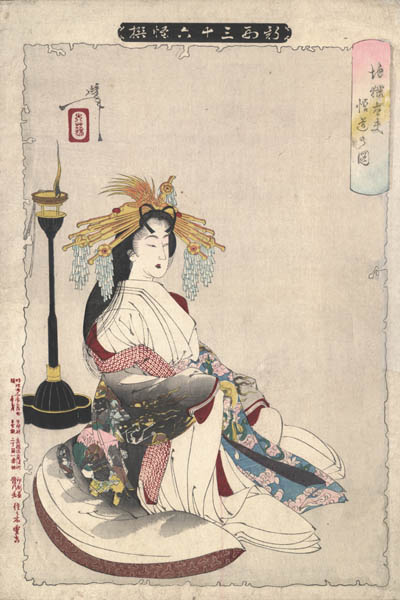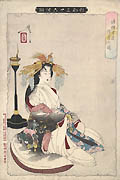| Title: |
The Enlightenment of Jigoku-Dayu 'Jigoku-Dayu godo No Zu' |
| Artist: |
Yoshitoshi, Tsukioka (Japan, 1839 - 1892) |
| Date: |
February 20, 1890 |
| Medium: |
Original Japanese Woodcut |
| Publisher: |
Sasaki Toyokichi |
| Series: |
New Forms of Thirty-Six Ghosts |
| Note: |
Tsukioka Yoshitoshi: The undisputed master of Meiji
period art dating between (1868 & 1912), Tsukioka Yoshitoshi's woodcuts are now ranked beside those of Hiroshige,
Hokusai and his former master, Kuniyoshi. Yoshitoshi became a star pupil
of Kuniyoshi at the young age of eleven and, in 1853, designed his first
published woodcut print at age fourteen. Until 1860, Yoshitoshi's art
was influenced by the dominant Utagawa style, but after that date he broke
out into a striking form of artistic expression that was all his own.
Daring colour combinations combined with dramatic and expressive postures
began to lead the way, quickly influencing an entire era of Japanese art.
This is all the more remarkable when one considers that through most of
his life Yoshitoshi was continually afflicted with serious eye disorders
and mental breakdowns. At the time of his death, Yoshitoshi's fame was
so widespread that he had over eighty recorded pupils. |
| |
Deservedly, Tsukioka Yoshitoshi is now one of the most sought after
of Japanese woodcut artists. The Enlightenment of Jigoku-Dayu
is ranked as one of his finest late works of art. |
| |
New Forms of Thirty-Six Ghosts: The Enlightenment
of Jigoku-Dayu originates from Tsukioka Yoshitoshi's last great set of woodcuts
entitled, "New Forms of Thirty-Six Ghosts". Within
this series of thirty-six prints one finds the beauty, the horror and
the wonder that distinguishes Yoshitoshi's genius. Work on the "New Forms of Thirty-Six
Ghosts" was spread over a three year period, from 1889 to Yoshitoshi's
death. Each woodcut was put on sale as soon as it was printed and published
by Toyokichi. The set was extremely popular and a second edition was
issued by Matsuki Heikichi in 1902. Distinguishing impressions from the two
editions is very easy. The first edition woodcuts display vibrant colours
where later impressions relied upon a more subdued, almost pastel palette.
Furthermore, John Stevenson, in his book, Yoshitoshi's Thirty-Six Ghosts,
writes,
"The cartouche at the top right frames the title of the design. The colors
in this cartouche are a clue to the impression. Three well-delineated
colors show the print to be among the first off the blocks. On subsequent
pullings, the colors in the cartouche are lighter and number only two." *
|
| Edition: |
There can thus be no doubt that this impression of The
Enlightenment of Jigoku-Dayu is extremely early. It is in fact a variant
impression. or, in Western terms, a trial proof before publication. Comparing
this impression to the published one in Stevenson's, Yoshitoshi's Thirty-Six
Ghosts, one can immediately see that this impression was taken before
the final block comprising the courtesan's procession of skeletons was
added. And although every line in the depiction of Jigoku-Dayu matches
perfectly with the published first edition impression, there are significant
changes in colour modulations upon her robe. This is most noticeable on
the lower left of the robe, where the scenes of Buddhist Hell are depicted.
In this variant or trial proof impression, Tsukioka Yoshitoshi and his printer
have darkened the flames and blackened both the skin of the man-creature
and the face above him. In fact, the face in this impression appears much
more like that of a black cat than the tormented human face we see in
the final version. |
| |
The importance of this unique trial proof impression is
clearly evident. Because it has survived we are privy to a glimpse into
the remarkable mind of Yoshitoshi and how he built The Enlightenment of
Jigoku-Dayu into one of his last great masterpieces. |
| Raisonne: |
* John Stevenson, Yoshitoshi's Thirty-Six Ghosts, John
Weatherhill Inc., New York, 1983 |
| |
Catalogue # XIV. A Unique Variant State before publication
of the first edition.(Photographic reproductions from this text are provided
as well as Stevenson's thematic comments regarding the woodcut.) |
| Size: |
Oban (Sizes in inches are approximate, height preceding width of plate-mark or image.) |
| |
Framed and Matted with 100% Archival Materials |
| |
View larger Framed Image |
| |
 |
| Condition: |
Printed upon fine 19th century Japanese mulberry (rice)
paper and with full margins as published by Toyokichi on the above date.
There is slight soiling in the margins, else a magnificent impression
bearing all the fine lines and vibrant colours of an initial printing.
This is a unique variant or trial proof impression of this most famous
woodcut by the Japanese artist, Tsukioka Yoshitoshi. A more important example of Yoshitoshi's art will not be found. |
| Price: |
Sold - The price is no longer available. |
| Important Information: |
The artist biographies, research and or information pertaining to all the original works of art posted on our pages has been written and designed by Greg & Connie Peters exclusively for our site, (www.artoftheprint.com). Please visit us regularly to view the latest artworks offered for sale. We will soon be posting an update of our most recent research and include the biographical and historical information pertaining to our next collection of original works of art created by artists throughout the centuries. We hope you found the information you were looking for and that it has been beneficial.
Our Gallery, (Art of the Print / www.artoftheprint.com) guarantees the authenticity of every work of art we sell 100%. Full documentation and certification is provided. We offer a wide selection of international fine art dating from the early Renaissance to the contemporary art period. |










![]()
![]() or
phone Greg & Connie (905) 957-6666
or
phone Greg & Connie (905) 957-6666